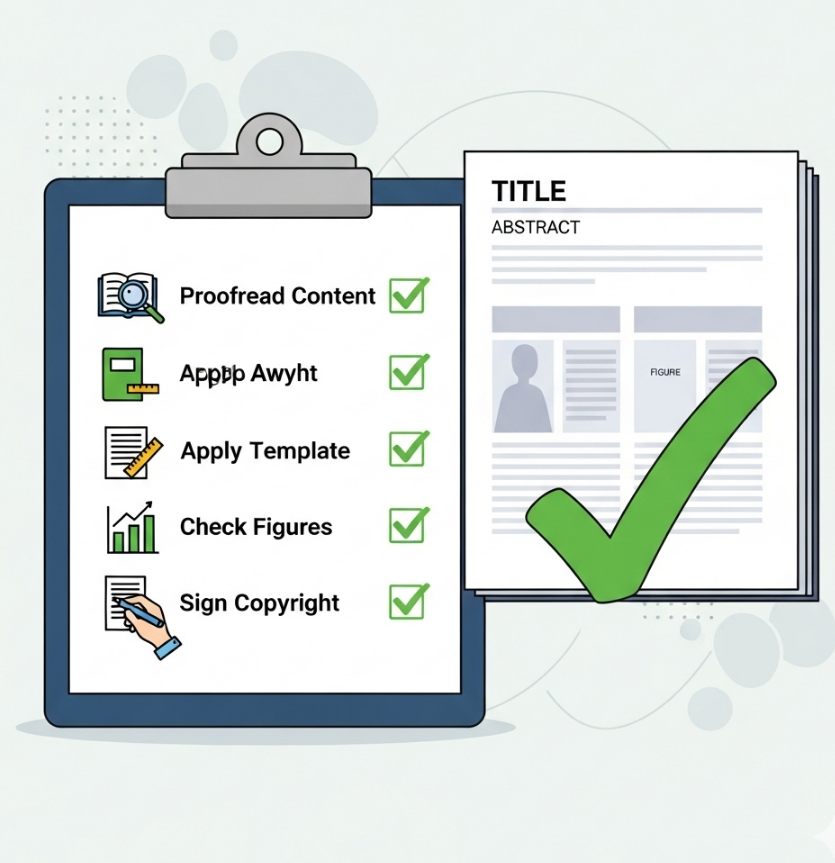Your paper has been accepted to a
conference—congratulations! This is a major achievement. Now, you’ve received
an email asking for the "camera-ready" version. This is the final and
most crucial submission stage. The version you submit now is the one that will
be published in the official proceedings, so it must be perfect.

The term "camera-ready"
originates from the print era, meaning a document was literally ready to be
photographed for the printing plates. Today, it means your digital manuscript
must be flawlessly formatted and finalized for publication in platforms like
IEEE Xplore, the ACM Digital Library, or SpringerLink.
To help you navigate this critical step,
here is a detailed checklist of what to pay attention to before you click
"submit."
Phase 1: Content and Text Finalization
Before you even think about formatting,
ensure the content itself is finalized.
- Incorporate Reviewer Feedback:
Methodically address every comment from the peer reviewers. Even if your
paper was accepted with minor revisions, carefully implementing this
feedback is expected and significantly improves the quality of your work.
- Final Proofread for Language: This
is your last chance to fix typos, grammatical errors, and awkward
phrasing. Read the paper aloud to catch unnatural sentences. Use
grammar-checking software like Grammarly, but do not rely on it
completely. Ask a colleague, especially a native English speaker, to read
through it one last time.
- Check Author Information: Verify
that all co-authors are listed in the correct order and that their names
and affiliations are spelled correctly. Ensure email addresses and other
contact details are accurate.
- Write Your Acknowledgments: Add the
acknowledgments section to thank your funding agencies, lab members who
provided support, and anyone else who contributed to the research.
Phase 2: Strict Formatting and Layout
This is where most authors run into
trouble. Formatting for the camera-ready version must be exact.
- Use the Official Template: Download
and use the official conference template (e.g., LaTeX or Word) provided by
the publisher (IEEE, ACM, Springer, etc.). Do not try to create your own.
- Verify Margins, Columns, and Spacing: Do not adjust the template’s predefined margins, column
widths, or line spacing. Even small changes can cause your paper to be
rejected by the automated format-checking systems.
- Check Font Types and Sizes: Ensure
all text, from the title to the figure captions, uses the correct font
(e.g., Times New Roman) and size as specified in the template. Pay close
attention to the formatting of headings and subheadings.
- Adhere to the Page Limit: You must
be within the strict page limit. If you are over, you will need to edit
your content down—do not try to cheat the limit by reducing spacing or
margins. Some conferences allow you to purchase extra pages, but check the
policy first.
Phase 3: Figures, Tables, and References
These elements are often overlooked but are
critical for a professional look.
- Ensure High-Resolution Figures: All
graphs, images, and diagrams must be high-resolution (at least 300 DPI)
and legible. Blurry or pixelated figures are a common reason for rejection
at this stage. Ensure all text within the figures is readable.
- Check Figure and Table Placement:
Figures and tables should be placed at the top or bottom of a column/page
where possible, and they must be referenced in the text before they
appear.
- Verify All Citations and References:
- Style: Ensure your reference list
is perfectly formatted in the required citation style (e.g., APA, IEEE).
- Completeness: Check that every
reference in the list is cited in the text, and every in-text citation
has a corresponding entry in the reference list.
- Accuracy: Double-check author
names, publication years, and titles in your reference list.
Phase 4: The Final Submission Package
You're almost there. The final step is to
package everything correctly.
- Generate a Compliant PDF: The
conference will have a tool (like the IEEE PDF eXpress) to check if your
PDF file is compliant with the publisher’s standards. You must use this
tool to validate your file or to convert your source files into a
compliant PDF.
- Complete the Copyright Form: You
will be required to sign and submit an electronic copyright transfer form.
This legally transfers the copyright of the paper to the publisher,
allowing them to publish it.
- Check for Additional Requirements:
Read the submission instructions one last time. Do you need to submit your
source files (Word or LaTeX)? A short author bio?
- Final Upload and Verification:
Upload all required files to the conference submission portal. After
uploading, download the file from the portal to ensure it was not
corrupted and that it is the correct version.
By meticulously working through this
checklist, you can ensure your camera-ready submission is professional,
polished, and accepted without any issues, securing your contribution to the
scientific record.


